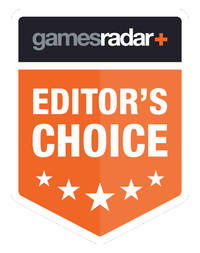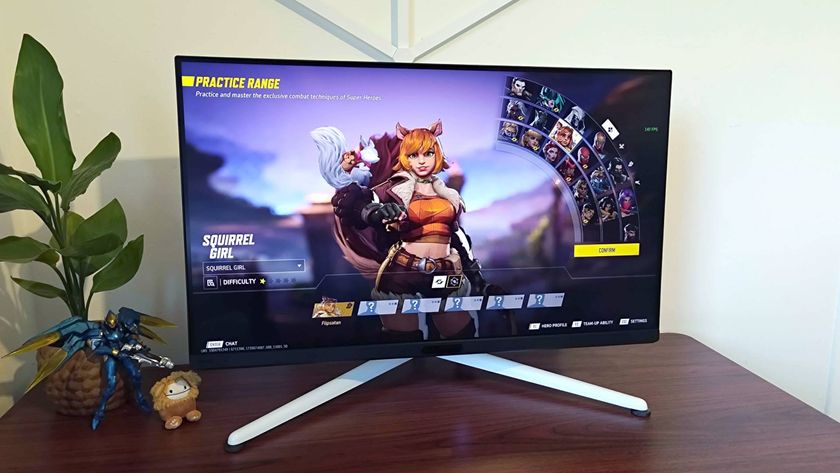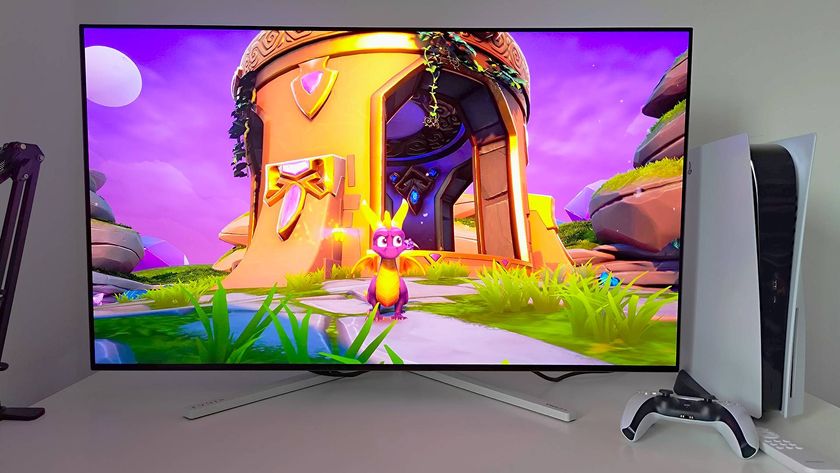12DOVE Verdict
With all the brilliance of a sunbeam, the Samsung QN95A ushers in the era of Mini-LED and the result is a dazzling 4k HDR TV that gamers will adore.
Pros
- +
Astonishingly bright, vibrant pictures
- +
4k 120Hz HDMI 2.1 inputs
- +
Game bar interface
Cons
- -
Hefty One Connect Box
- -
No Dolby Vision
Why you can trust 12DOVE
The Samsung QN95A is a hell of an introduction to the screen giant's new Neo QLED panel; a next-generation flatscreen illuminated by a densely clustered Mini-LED backlight, rather than a conventional full-array or edge lighting. The difference this innovation makes is profound and the best QLED TV lists across the internet will start to feature a number of such TVs, I'm sure.
Couple this with an advanced AI-powered Neo Quantum 4K processor that uses Deep Learning, and an Intelligent Mode which auto-pilots the screen for the smoothest viewing experience, and the QN95A showcases Samsung at the top of its TV game.
As befits a 4K flagship for 2021, there are other attractions too. The set debuts Game Bar- a new interface that allows players to tweak and tinker, meaning it really can be the best gaming TV - plus an improved version of Samsung’s OTS+ multichannel Object Track Sound system.
Features & Design
The QN95A packs a lot of new tech into a chassis just 25.9mm deep. It’s a smart-looking affair, with an inconsequential bezel and tidy wraparound frame. The whole shebang sits on a central pedestal.
The TV comes with two remote controls: a standard zapper with the usual plethora of buttons, and a slim alternative that has a solar cell panel that charges using indoor lighting (and a USB C port). The compact option is the one to go for as it’s the only controller (that I could determine) which calls up Samsung’s Game Bar UI.
Of course, what immediately sets the QN95A apart from its stablemates is the One Connect Box. This outboard junction has had a redesign, but it’s still a considerable unit. The One Connect Box delivers sound, vision, and power to the panel via a single fibre optic cable. Therefore, games consoles and other TV sources connect to the Box, rather than the set.
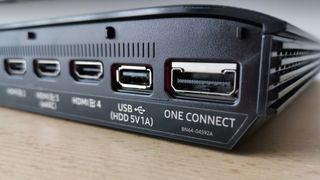
All four HDMI inputs provided are v2.1 certified and support 4K 120Hz video from PlayStation 5 and Xbox Series X consoles. There’s also ALLM (Auto Low Latency Mode), and VRR (Variable Refresh Rate) on board, with eARC available on HDMI 3 for connection to soundbars and external audio systems. Also provided is an optical digital audio output, three USB connectors, and Ethernet. Wireless support covers Bluetooth v4.2 and Wi-Fi, with Apple Airplay 2 compatibility.
There’s no significant change to Tizen, Samsung’s smart TV platform. Apps and smart functionality are still accessed via the launcher ribbon that runs across the bottom of the screen. You’ll find a comprehensive selection of streaming apps available, including Netflix, Prime Video, Apple TV+, YouTube, Disney+, and Now, in addition to all the key catch-up TV services.
Samsung’s menus can be a bit labyrinthine, but the Game Bar is a dedicated interface for simplifying tweaks and adjustments. You can select a custom aspect ratio (21:9 or 32:9), monitor HDR and input lag, and so on. The latency is good: we measured input lag at 10.1ms (1080/60), in the standard Game mode. Combine this with the HDMI 2.1 connectivity, and this is already looking like a nailed-on dead-cert to be near the top of the best TV for PS5 and Xbox Series X and best 120Hz 4K TV lists.

Performance
The QN95A deserves its Neo QLED moniker. What we’re seeing here, courtesy of that Mini-LED backlight, is something entirely new for LED TVs, eclipsing the performance of even posh FALD (Full Array Local Dimming) models. The backlight module has been completely reimagined. With some 792 Mini LED zones at work, the screen presents a tonally uniform and aggressively bright display.
The QN95A also utilises Samsung’s most advanced image processor. The Quantum 4K processor with multi-intelligence deep learning has 16 times the capacity of its predecessor to optimise video processing. Small wonder it looks so good when upscaling HD sources to 2160p.
HDR support covers HDR10, HLG, and HDR10+ Adaptive, the latter an update of the HDR10+ dynamic metadata standard, which uses the TV light sensor to manage HDR. But there isn't a provision for Dolby Vision, which is careless given that Samsung has partnered with Xbox, and only Xbox is rolling out Dolby Vision HDR games. Overall though, the set’s HDR performance is terrific. We measured peak brightness on the Standard image preset with local dimming on a default Standard setting, at 1300 nits. You can coax even more from the panel if you set Local Dimming on High. This means the screen doesn’t have to aggressively tone map content mastered with a 1000 nits ceiling (which is the broadcast standard).
There’s a host of image presets available, but we suggest sticking with the Intelligent Mode, which really brings out the best in the set.
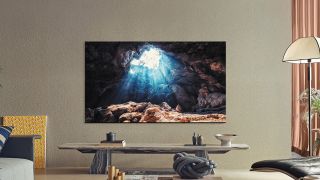
The TV boasts an excellent black level performance, presenting letterbox bars in solid black rather than grey, with a greatly reduced chance of blooming around bright objects.
What constantly catches the eye is the superlative detail, however. A run-through of Marvel’s Spider-Man Remastered on the PS5 is a visual revelation. The texture of Spidey’s costume looks almost tangible. Exquisite pin-pricks of light enliven Peter Parker’s eyes. Similarly, the sunlit NTC vistas are spectacular, if often startlingly bright. Indeed, this is the best bright room LED TV you can buy right now. It maintains pop, colour and contrast even in rooms with high levels of ambient light.
Intelligent Mode also helps audio, adding weight and impact. The TV actually uses eight speakers, including two up high on the rear, for its Object Tracking Sound system. OTS+ directs and pans sound around the screen, to great effect. The need for one of the best surround sound systems might not be as immediate as one might think when getting this television.

Overall - should you buy it?
Believe the hype. Mini-LED really is a transformative new technology and a perfect complement to Samsung’s Quantum Dot colour technology. It’s not just impressive HDR, but it boosts SDR too. For bright room viewing, this screen is unbeatable. Samsung has upped its game for players too. Unlike OLED, there’s no worry about screen burn, as Neo QLED is immune from such irritations.
We rate this Neo QLED 4K HDR screen a worthy flagship. The adoption of Mini-LED sets a new standard for Samsung’s QLED fleet, offering dynamic, almost three-dimensional imagery. It’s also ideal for bright room viewing and gaming sessions.
A quartet of 4K 120fps inputs, plus the new Game Bar interface, should sate most power users. That said, the One Connect Box will only really appeal if you’re wanting to wall-mount and need to reduce the amount of cabling going to the screen. The lack of Dolby Vision will also be a major turn-off for film fans.
Overall though, we’re sold on Neo QLED; 4K HDR has just received a major upgrade.
Steve May is a home entertainment technology specialist. Creator of Home Cinema Choice magazine, Steve writes about gadgets and gizmos for GamesRadar, T3, Louder Sound, TechRadar, Home Cinema Choice and Yahoo. He’s also the editor of The Luxe Review and Pro AV site Inside CI. Steve once wrote a games column for legendary British comic 2000AD (and has a badge to prove it), and maintains that when it comes to top shooters, Doom is the GOAT.
Most Popular




